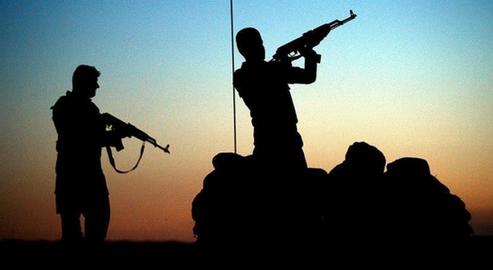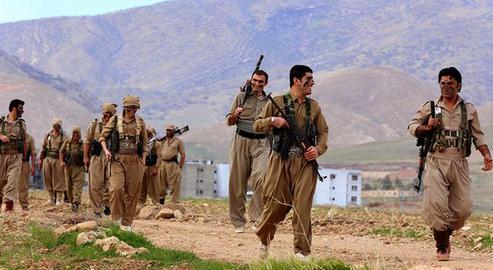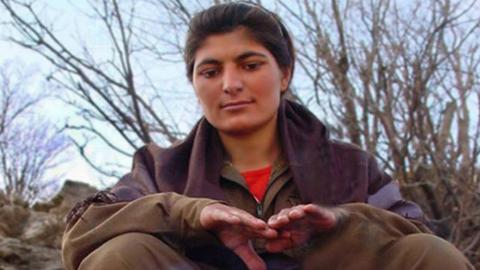The Islamic Republic of Iran has carried out more assassinations in Iraqi Kurdistan than in any other country or region of the world, with 259 people killed and at least 121 seriously injured in state-sponsored attacks in this territory since 1979.
Political assassinations by Iran inside Iraqi Kurdistan began in the early 1990s and peaked from 1993 to 1997. But even today, the safety of any political opponents of the regime who travel or flee to Iraqi Kurdistan – as well, of course, as Kurdish critics of the Islamic Republic and independent Kurdish journalists – remains under threat.
A Window of Opportunity Created by Conflict
Iran’s political inroads in Iraqi Kurdistan began in 1991 with the Sha’aban Intifada: a series of popular uprisings in Iraq in 1991, which Kurdish nationalists, Shia Islamists, far-left organizations and others took up arms against Sadddam Hussein’s government.
In the first two weeks of the month-long conflict, during which tens of thousands would ultimately be killed and around two million people displaced, the Patriotic Union of Kurdistan (PUK) and the Kurdistan Democratic Party (KDP) seized control of large areas of Iraqi Kurdistan. US-led coalition forces established a no-fly zone over northern Iraq to prevent airstrikes by Saddam Hussein’s regime against the Kurds. This, in turn, created an opportunity for the Iraqi Kurdish party to enter a new chapter in economic co-operation and relations with the Islamic Republic of Iran, which at that time was already badly debilitated by UN sanctions.
In 1994, civil war broke out between the dominant rival Kurdish factions – most notably the PUK and the KDP. The conflict lasted for around four years and drew in both Iranian and Turkish Kurds and state military forces from Iran, Iraq and Turkey, before an armistice was declared in September 1998. During that period some 3,000 to 5,000 fighters and civilians were killed, infrastructure destroyed and the local economy dealt a crippling blow.
Until 1996 the Iranian regime had closer relations with and provided support to the KDP, but switched allegiances after the PUK allowed the Iranian air force to bombard Iranian Kurdish opposition groups based in the Iraqi town of Koya. The chaos of the conflict meant Iran was more or less free to both recruit local fighters to serve its own ends – and to assassinate its opponents.
Who Did Iran Target in Iraqi Kurdistan?
Jafar Aminzadeh is a former member of the Central Committee of Komala, the Kurdish branch of the outlawed Communist Party of Iran. Now living in Sweden, he told IranWire that in his view, both during and after the Sha’aban Intifada, the Iranian state has had two main goals in Iraqi Kurdistan: “The suppression of opposition parties, and gaining greater influence to access Syria and Lebanon.”
During the same period, Aminzadeh says the Islamic Revolutionary Guards Corps established security ties with smaller Kurdish factions as well as the main groups, including the Kurdistan Islamic Movement and the Kurdistan Socialist Party. "I think the seeds of the Shiite Crescent were sown at the same time," he says.
"Along with political developments in Iraqi Kurdistan, the headquarters of the Iranian Kurdish parties, including Komala and the Democratic Party of Iranian Kurdistan, moved from areas near to the border – which left them in a very fragile security and military position – deeper into Iraqi Kurdistan.”
Most of the Iranian Kurdish parties were restricted in what they could achieve militarily and focused on covert and underground activities in the region. Their lack of defense capabilities and the precarious local economy made individual members easy targets for Iran’s military forces.
A wave of assassinations of Iranian Kurds and other political dissidents consequently took place in northern Iraq. The main target was members of the exiled Mojahedin-e Khalq Organization (MKO), better known as the People’s Mojahedin. But Iranian forces also targeted scores of people in the Ranjbaran (Laborers) Party – an Iranian Marxist-Leninists organization in exile, the Organization of the Iranian Kurdistan Struggle, better known as Khabet, the Iranian separatist Kurdistan Freedom Party or Azari Party, Komala, and the Democratic Party of Iranian Kurdistan (PDKI) – as well as countless individuals who had simply fallen foul of the regime.
“The assassinations,” Aminzadeh says, “encompassed everyone: from party officials to peshmergas, military commanders and senior cadres to individuals who were not members of any political party or organization.
“In June 1995, for instance, two Komala activists named Osman Farman and Osman Kiani were shot and killed near the headquarters of the Patriotic Union of Kurdistan in the city of Sulaymaniyah. The assailants were five people, who opened fire at them from inside a taxi.”
All five of the assassins were immediately arrested, interrogated and tried by the PUK’s own security forces. "After a while, we were given the tape of the confessions. After listening to it we obtained more detailed information that showed how Iran’s deputy director of intelligence in Urmia had identified the dissidents, and what methods are used to gather information and organize the assault."
He says: "Through these confessions, we found out that the headquarters in Urmia had organized a group called Raparin (Revolution), led by a man named Kamal Mawti, to identify and carry out the killings of these people. Kamal Mawti was from the village of Mawt in Iraqi Kurdistan. As far as I know, he is still alive and well, living in the city of Urmia under protection.”
According to Aminzadeh, all the members of the killing squad were Kurds from the city of Baneh in Iran’s Kurdistan province. "It’s worth pointing out,” he says, “that these people didn’t know the difference between Komala and the Democratic Party peshmergas at all. They did what they did for the money. But I don’t remember if anyone else, other than these five, were ever arrested or tried for the assassination of political dissidents.”
‘Everyone Who Fled Iran Was in Danger’
Farrokh Nematpour, an Iranian-born Kurdish journalist and novelist living in Norway, also has personal experience of this period. While living in exile in the city of Sulaymaniyah, he had no formal party affiliation but was a critic of the Iranian regime, collaborating with Kurdish magazines including Raman, Caravan and Bryate. This was enough to put his name on the hit list.
"In Sulaymaniyah,” he tells IranWire, “we had to protect themselves by every means possible. We could not stop to sleep or eat and were always on the alert, especially at night. Everyone who had fled Iran for political reasons, be they party members or independents, was in danger. We had no choice but to travel irregularly to ensure our own safety. In short, we had prepared ourselves for any eventuality, including death. The firearm I had to protect myself with was always readied, with the safety catch off.
"One of my friends from Baneh told me that I was on the terror list, and that it would be best for me to leave Iraqi Kurdistan as soon as possible. This friend had it on good authority that two people in Baneh were working on getting the names of Komala and Democratic Party members.”
The pair, Nematpour was told, were called Ahad and Rahmani. Their role was to provide the names and details of dissidents to local agents in Iraqi Kurdistan, who would then track them down. “Rahmani's name became well-known among the opponents of the Islamic Republic in Sulaymaniyah,” he says. “He became infamous.”
It wasn’t until the threat to his life became evident that Nematpour finally decided to leave his adoptive city. “I was returning home with a friend when I noticed a red Toyota following us,” he recalls. “We immediately made our way toward a more crowded place.
“A few days later, on returning from a visit to a friend, neighbors told us that a group of gunmen had come by and were trying to enter the house. I contacted the security divisions of Komala and the Democratic Party the next day and became convinced that they were terrorists. After this incident, I left Sulaymaniyah for [the capital of Iraqi Kurdistan] Erbil."
Local Killing Squads Armed by the IRGC
Jafar Aminzadeh believes the assassinations would not have been possible without the support of local forces in Iraqi Kurdistan who acted on behalf of the IRGC.
"One night,” he says, “at around 8pm in the summer of 1996, one of the assassination squads was on the junction leading to the village of Zargoviz, close to Komala’s main headquarters. An armed clash with our security team broke out and they fled.
“When the fight was over our team seized a mortar from them, together with five rounds. The shells were fresh – new – and the stamp of the Revolutionary Guards was on them.
“We immediately informed the PUK’s security services about the clash and handed over the confiscated weapons. Later, we later learned that the operation was planned jointly by the IRGC and some members of the Iraqi Kurdistan Socialist Party.
"The Islamic Republic uses every means at its disposal to eliminate the opposition, from bombings to shootings to rocket attacks. In 1993 a bomb was planted under our car in Sulaymaniyah, in front of Komala’s local branch office. Eventually it was discovered and defused in time.
“Some nights, they shot at the central camp with RPGs and rifles. Later on in 1993, in September, Komala’s central encampment was hit by a missile. Also that year, a minibus carrying the families, wives and children of Komala members was fired at on its way back from Sulaymaniyah. In July 1996, the Democratic Party’s camp was attacked by artillery, mortars and Katyusha rocket launchers just 250 km inside the Iraqi border.”
Attacks on Kurds in Iraq Continue Today
Since the early to mid-1990s, Aminzadeh concedes that the number of Iran-sponsored killings on Iraqi soil has predictably declined. But the sporadic assassination of political opponents in Iraqi Kurdistan still continues to take place, just as it does in Turkey and elsewhere in Europe. "[Dissidents] Ghader Ghaderi, Salah Moradi Ahmad Amir-Ahmadi, Sabah Rahmani, Salah Rahmani and Eghbal Moradi were assassinated between 2016 and 2018 in Iraqi Kurdistan,” Aminzadeh says.
The Democratic Party of Iranian Kurdistan has compiled its own report into the alleged killings of its members by Iran, both inside Iraqi Kurdistan and around the world. In the report, the party listed the names of 340 people it says have been assassinated on behalf of the Islamic Republic since its foundation. The party’s headquarters was targeted by an IRGC missile attack in September 2018 that killed 16 people and injured more than 50 others.
“A common feature of all these cases of assassinations,” the Democratic Party stated, “is that, because of an unstable political situation or due to political reasons, almost none of the cases have been investigated, nor have the perpetrators of these political crimes been brought to justice.”
Related coverage:
Kurdish-Iranian Negotiations: What Do They Mean?
visit the accountability section
In this section of Iran Wire, you can contact the officials and launch your campaign for various problems


























comments